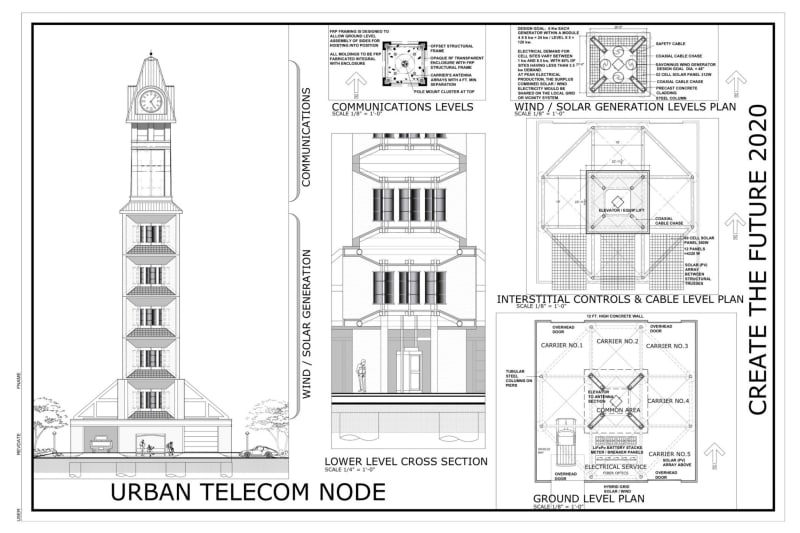Urban Telecom Node
A rising and sustained use of telecommunications, both commercial and personal, has been beneficial yet demanding on financial resources on providers and consumers alike. Energy consumption for 24/7 transmission is a nominal part of this circumstance.
Decreasing this cost factor by the utilization of solar and wind supplementary energy would yield numerous benefits to the service providers in the way of system upgrades, sustained , if not reduced rates, and employee benefits. The consumer would continue to enjoy the ever-improving offerings at less cost or slower escalation.
Use and Design
Replacing some of the existing wireless cell site structures with one that is better suited for the urban environment has tangible advantages. There is the economical factor of energy cost reduction and sell-back achieved with solar arrays supplemented with the vertical axis generators shown in the conceptual drawing. In addition, there is the potential for visually improving the city scape by the reduction of utility structures used in the growth of wireless networks.
The concept presented is proposed as a replacement structure that would be built as off-site modular components and transported to the site for erection. This would leave the cell site live until the time of switch over. The footprint of the new structure is relatively small (23 ft. x 23 ft.) not including the open, stand-off trusses. The cell sites are ordinarily tight in urban areas. If it were impossible to maintain the existing lattice or monopole in operation, it would be necessary to either expand the site or use temporary telescoping trailer units during erection of the new structure.
Construction
The structure is divided into two different primary structural frames. First, is the typical A-36 large diameter pipe columns and beams with stand-off trusses at the base. The second primary frame is FRP (Fiber Reinforced Plastic) that is RF (radio frequency) transparent yet having exceptionally good structural characteristics. This is the Antenna Enclosure sheathed with an RF transparent paneling on FRP struts. The lower A-36 steel frame is encased in precast, high strength concrete panels that have access sections for access to the coaxial cable racks up to the Antenna Enclosure.
Renewable Energy
Wind and solar energy, having little impact on the environment, lend themselves as answers to energy demands in a climatically changing world. Finding ways and means to utilize this potential in a commercially viable manner is the challenge of the Urban Telecom Node. The appropriate number of vertical axis generators and the maximum number of solar panels on a given site is the design intent.
Assumption
Solar: 12-60 cell panels = 4,320W Tower Arrays: 5 Levels 104 active cells/level = 3,120W
Wind: 5 Levels 4-VAWTs each @ 4 kW each = 80 KW
80% of cell sites in U.S. have an electrical demand of less than 3.5 KW
Like this entry?
-
About the Entrant
- Name:Kenneth Ballew
- Type of entry:individual
- Software used for this entry:AutoCAD
- Patent status:none

